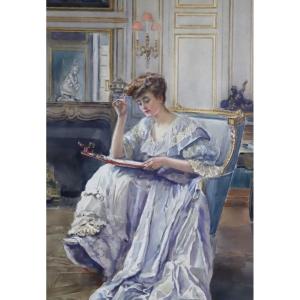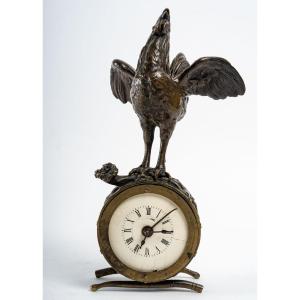Louis Ernest BARRIAS (Paris, 1841-Paris, 1905) - Mozart Child, 1883 - Bronze print with brown patina depicting the young prodigy at the age of nine "in the very natural pose of a little Paganini agreeing the strings of his violin" before "improvising the most ravishing melodies" (T. Véron, 1883). Old cast iron from the Parisian art bronze publishing house Ferdinand Barbedienne, based on the "life-size" plaster model presented by the artist-sculptor at the Salon des Artistes Français of 1883 (n°878).
Titled on the base: "MOZART". Signed in cursive letters on the terrace and dated: "E.Barrias 1883". Cast iron from Maison Barbedienne numbered "94" and signed on the back of the terrace ""F.BARBEDIENNE Fondeur Paris". Mechanical reduction stamp of Achille Collas.
During the National Exhibition of Fine Arts of 1883, Ernest Barrias, already considered one of the most fertile and brilliant statuary of the French School of Sculpture of his generation, presented, to the great dismay of seasoned art critics , from the Salonnier public won over by the ample, inspired and flexible talent of this artist "with a sensitivity always on the alert", three works which, alongside his sumptuous, stunning allegory of "Nature revealing itself to Science" (1897, Paris, Musée d'Orsay), will be considered during his lifetime or even a posteriori by his informed biographers (Georges Lafenenestre) as the jewels of his "fruitful, exemplary career", "artistic" of the best conducted and the best fulfilled": The First Funeral: Adam and Eve taking the body of Abel (group, marble, n°876-.Paris, Petit Palais), Bernard Palissy (statue, bronze, n°877), Mozart Child (statue, plaster, n°868) .
In an article (Gazette des Beaux-Arts of July 1, 1883) devoted to this very popular event, Paul Lefort delivered, in an enthusiastic pen, his impressions of the sculptural creations presented by E.Barrias within the Triennal Salon. Regarding "the adorable figure of Mozart as a Child", he immediately underlined:
"The author of the First Funerals, this group of such deeply moved and lofty inspiration, gave the public a very lively and charming surprise by sending to the National Exhibition the plaster, not yet previously known, of a figure in full length representing Mozart as a child. This is only a statuette (...) But how amiable and attractive this little figure is! Mozart is standing, tuning his violin which he rests on his raised knee; his head slightly inclined, he questions with his ear and his finger the accuracy of one of the strings of the instrument. Presently, he is going to use it, and, as reported in the letter from his father cited in the Livret , and who provided Mr. Barrias with the first idea for this statuette, he will improvise the most ravishing melodies."
Conquered by this sculptural work of an ingenuous composition, of an original or even unprecedented approach on the part of a statuary more inclined, by his academic training as by the impetuous nature of his talent, to treat allegorical subjects with moral or philosophical specific to the "noble genre" appreciated by the state authorities of the Third Republic, the journalist continued his comment in these terms:
"It is nature itself that Mr. Barrias caught in the act and which he rendered in this movement, in this childish attitude, with inexpressible grace and kindness. Moreover, everything in this exquisite work is treated with the same happiness: the physiognomy of the young musician is alert, fine, smiling and at the same time very attentive; the gestures are of a precision of observation and a perfect truth; the hands are indeed hands of a musician and a child; the little legs are slender and nervous; finally, under the coquettish 18th century costume, we absolutely feel the action and the thrill of life."
Since its presentation in 1883, the effigy of Mozart as a Child, praised by art critics, admired by amateurs and acclaimed by the public of the time, enjoyed real artistic fortune coupled with commercial success.
Rightly considered by Albert Soubiès as a "work of masterful and spiritual skill" (1905, p.7), it was not seen at the Salon of 1888 - a year after its translation into lost wax bronze (Salon of 1887). , n°3618) acquired by the State for the Luxembourg Museum (Paris, Musée d'Orsay, Inv. RF 785 LUX 6) - no equivalent. “Following the success obtained by the Mozart child, by M.Barrias”, commendable statuaries (Moreau-Vauthier, Laoustt, Gaudez, etc.) ventured onto the same terrain. From "the legion of adolescents, great men in the making" (Pascal, Lulli, Turenne, Molière) presented, Georges Lafenestre saw, in comparison with "the happy conception" of Barrias, "only childishness and childishness" devoid of " historical truth" (Revue des Deux-Mondes, July 1888).
Admiring the Mozart Child (Bronze, 1887) which has become "one of the most precious ornaments of sculpture at the Luxembourg Museum" (Léon Gonse), the Danish collector Carl Jacobsen (1842-1914), "generous admirer of French sculpture"
ordered a marble replica of it from E.Barrias. Presented at the Salon of 1891 (n° 2254), "this new interpretation" (nowadays at the Ny Carlberg Glypoteck in Copenhagen) was for the master statuary "the opportunity to show his skill at finding in marble, as he had already proven in bronze, the particular qualities which, in each material, can best contribute to the expression of a figure" (G.Lafenestre, 1891). Applause, disseminated through engraving (La Revue Illustrée, Gazette des Beaux-Arts, Le Courrier de l'Art), the Mozart Child of 1883 became, following the prediction of its rare detractors (Jules Antoine, Henry Jouin) more keen on male talent of Barrias, "a pretty statuette to reduce, intended for place in a living room or on a fireplace" thanks to "the Maison Barbedienne which will quickly make reproductions". Already editor between 1874-1884 of statuettes demonstrating "the gifts of fine tenderness, smiling freshness, delicate grace, wise fantasy" as well as "the elegant and easy talent" of the artist" - Children's Suite, on a Turtle , the Snail, the crab, the basket, the Amphora, the Piggy Bank, ... -, the famous Parisian House of Ferdinand Barbedienne, renowned for its Art Bronzes, seized the model. it was executed, in addition to the original dimension of 115 cm, thanks to the reduction process of Achille Collas, in various sizes, namely in three other dimensions (89, 66 and 47 cm). From 1883 to 1891, the press relates, among "the collection of bronzes, a reduction of works by the most distinguished Parisian artists", the presentation in national (Reims) or European (Antwerp, Brussels, Copenhagen) events of the Mozart Child by Barrias including a model "d "half a meter in height" will be acquired at the Antwerp Exhibition (1886) by the Spanish Infanta Isabella de Bourbon with the intention of offering it to the virtuoso violinist Jesùs de Monastério (1836-1903). First-rate museum institutions (London, Royal College of Music; Lancashire, Harris Museum and art Gallery, etc.) are proud to own the Mozart Child by Barrias published in bronze, dated 1887 and sometimes like our 1883 model. In this respect, it will be noted that this due to a House highly recognized for the excellence of its carving work and the science of its patinas respects the original work designed by the artist in which "the proof of early genius shines forth " (T.Véron) by Wolfgang Amadeus Mozart (1756-1791).
In the effigy of the young Mozart, a musician who during his brief existence worked, according to his gracious expression, "to put together the notes that love each other", we can singularly read the trajectory of a "convinced and sincere" sculptor striving to associate “the study of truth with the passionate pursuit of Beauty”. What he achieved with mastery in this work of exquisite lyrical sensitivity, the aura of which persisted during one of his last presentations (n°1441) at the Centennial Exhibition of 1900.
------------------------
Materials: Bronze with brown patina.
Dimensions: H.: 66 cm-; Diameter: 35 cm;-Pr. : 28 cm.
Beautiful condition.
---------------------------
Related literature: Kjellberg, Pierre, The Bronzes of the 19th century. Dictionary of sculptors, Paris: Ed. de L'Amateur, 1989, pp.49-51; -Lami, Stanislas, Dictionary of sculptors of the French School of the 19th century , 1919, Volume I, pp.53-61; - Peigné Guillaume, Dictionary of French Neo-Baroque sculptors (1870-1914), Paris: CTHS, 2012, pp.69-78.
Lafenestre, Georges, The work of Ernest Barrias, Paris: Renouard, 1908; idem, "Le Salon de 1888", in: Revue des Deux-Mondes, July 1888, p.170-171; idem, "The Salon of 1891, in: Revue des Deux-Mondes, July 1891, p. 932. - Véron Théodore, Dictionary Véron, or Memorial of art and artists of my time, Year 1883, pp. 181- 183; Lefort, Paul, 'National Exhibition of 1883, in: Gazette des Beaux-Arts, July 1, 1883, pp.460-461;- Soubiès, Albert, L.E.Barrias (1841-1905). Biographical notes, Paris: Flammarion, 1905, p.7.



























 Le Magazine de PROANTIC
Le Magazine de PROANTIC TRÉSORS Magazine
TRÉSORS Magazine Rivista Artiquariato
Rivista Artiquariato
